 Facebook
Facebook
 X
X
 Instagram
Instagram
 TikTok
TikTok
 Youtube
Youtube
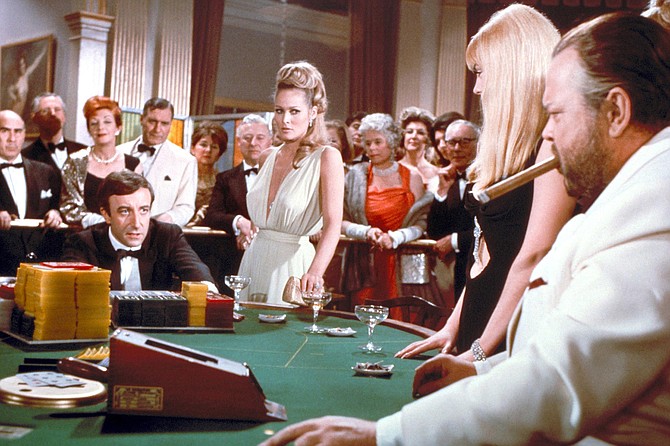
No, not that Casino Royale. The other, better one!
Casino Royale (1967)
We open with a postscript that can be found in the supplementary section of the DVD: it was Peter Sellers who suggested Orson Welles for the role of Le Chiffre in the 007 spy spoof Casino Royale, a move his ego later regretted. Sellers was so intimidated by Welles’ genius, he demanded the two not be filmed in the same shot. (Blows were exchanged when director Joe McGrath called him on it.) According to Sellers, who received an enormous salary plus a percentage of the gross, he walked off the set, never to return, because Welles and McGrath were ganging up on him. Months after monkey-wrenching the production, Sellers called director McGrath to arrange for a meeting over cocktails during which he apologized at length for his unprofessional behavior. McGrath recalls that in the middle of Sellers’ indefensible rant, one of Columbia Pictures’ head honchos walked over to the table to voice his own apologies to the director for everything that happened during the making of the film. He closed with, “And it was all that bastard Sellers’ fault.” According to McGrath, the executive then turned to Sellers and said, “We’re glad you’re here, Mr. Allen. It’s a pleasure to have you in our movie.” He walked away and Sellers said, “He thought I was Woody Allen. I’ve just had a check from him for a million dollars. And he signed it!”
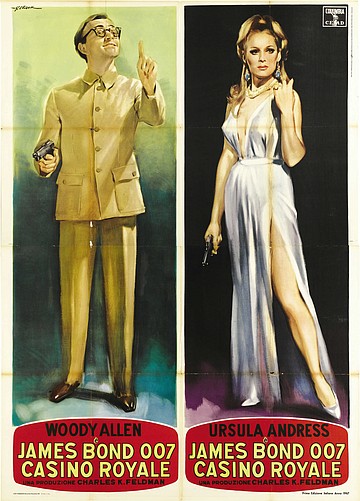
By the time of its release in 1967, the term “James Bond spoof” had become oxymoronic. Forgive me, thou disciples of Bondage, but aside from Dr. No, From Russia With Love, and On Her Majesty’s Secret Service, everything that follows, in some shape or form, owes a debt to campy, gadgetry-enhanced buffoonery for the easily amused. Villains topped by razor-brimmed derbys or goliaths whose annual dental visits are paid to can-opener repairmen are the stuff comic books are made of. Want to see the greatest Bond film you have never heard of? Check out Pierce Brosnan in John Boorman’s The Tailor of Panama. Want to see the guiltiest of all Bond guilty pleasures? Welcome to Casino Royale.
It was the first 007 novel to be penned by Ian Fleming and the only one not owned by Cubby Broccoli and Harry Saltzman’s Eon Productions. Producer/Super Agent Charles K. Feldman acquired the rights from the wife of his late client, producer/actor Gregory Ratoff. All efforts to work with Eon and acquire the talent of Sean Connery failed. David Niven, Ian Fleming’s original choice to play Bond, was a bit befuddled by the choice of a Scotsman to play his undeniably British spy. Rather than go up against the franchise, Feldman pitched it as a comedy and Columbia bit. Niven’s Bond lives in an “Eden without an Eve” and contrary from popular belief, the greatest spy in history abstains from sex. He represents an era when spying was an alternative to war and a spy was a member of a “select and immaculate priesthood” devoted to their work and disinterested in the type of sexual acrobatics associated with the character.
At the time, anthology films — several directors assigned short segments of a thematically-linked whole — were almost as conspicuous as spy films. Feldman didn’t have much in the way of a sense of humor, as evidenced by his choice of directors: John Huston, Ken Hughes, Robert Parrish, stunt coordinator Richard Talmadge, Val Guest, and Joe McGrath. Of the six, only the latter two had any noticeable aptitude for comedy.
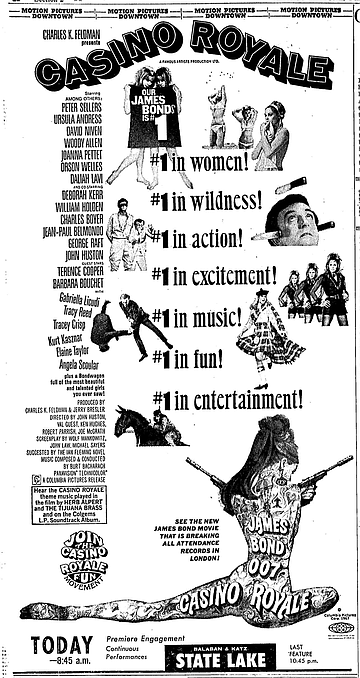
Who knows how much different the picture would have been had Sellers stuck it out? The smutty gag that opens the picture — Evelyn Tremble (Sellers) at an open-air Parisian urinal admiring Lieutenant Mathis’ (Duncan Macrae) “credentials” — was clearly intended to land much later in the film. As it is, it reflects a decision by committee, a harbinger of an oncoming spoof that only occasionally knows what it’s making fun of. After that, and for all too brief a moment, it appears as though Feldman looked to go head-to-head with the Eon series. Richard Williams’ animated opening credit sequence is right up there with the best of Maurice Binder. Check out the manner in which every actor’s credit foretells their character’s fate.
Huston’s decision to co-direct and act was made to the great delight of a bookie to whom he was in hock up to his orangutan-orange hairpiece. His segment opens the picture and if you can make it past the first 38 minutes, it’s relatively smooth, if narratively incoherent, sailing. According to Guest, Feldman instructed him to see how much footage they had of Sellers and if there was enough to continue on without him. When told yes, Feldman called Sellers in Spain and fired him. When Sellers leaves, the film careens away from comedy and in the direction of a psychedelic spoof. McGrath and Guest come off best, while Hughes and Parrish get lost trying to please the producer. (When asked if he’d like to be credited as “Segment Coordinator,” Guest called the film the least coordinated production he ever worked on.) Talmadge’s contribution oddly prefigures Blazing Saddles, what with its team of cowboys on horseback riding roughshod through the casino.
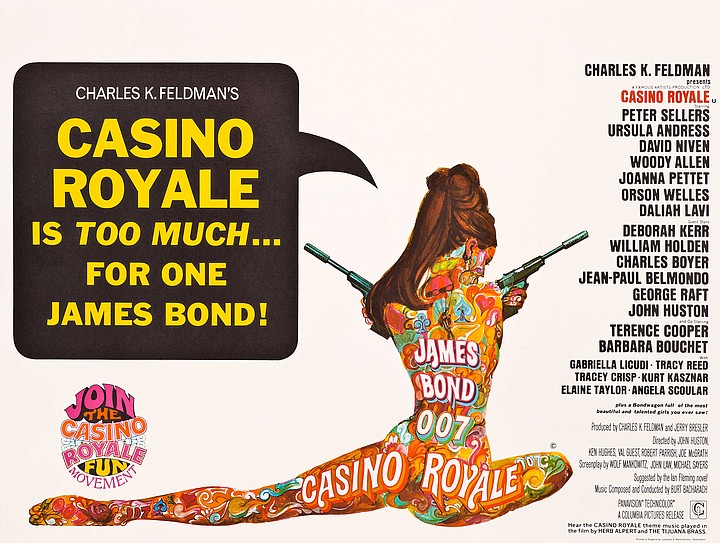
I was outraged the first time I saw this. It was nothing against Casino Royale, but rather, the sudden downpour halfway through the second feature, Jerry Lewis’ The Big Mouth, that necessitated an early exit from the drive-in. For years, I have championed it over Martin Campbell’s snoozefest royale. Seeing it again for the first time in over two decades, there are images that refuse to fade, most notably the slow-mo entrance of Sellers and Ursula Andress, underscored by Burt Bacharach’s “The Look of Love” and shot through an aquarium, bubbles gurgling like little diamonds that fill a quarter of the screen.
Jack Hildyard (Caesar and Cleopatra, The Bridge on the River Kwai, 55 Days at Peking) was a member of Britain’s old guard, a cinematographer who put time and care into crafting each shot. His insistence on using arc lights — they took 20 minutes to warm up — later caused McGrath to complain that they were lucky if they got a minute of film in the can each day. And a Bond film without Monte Norman’s iconic guitar theme might have felt more apparent had it not been for the score; Herb Alpert and the Tijuana Brass riding stereo herd on the title tune is as good a Bond theme as any out there. (This is the only 007 film to foster two hit songs.) Feldman knew as much about music as he did comedy. He called "The Look of Love" “artist shit,” and told Bacharach to remove it because it wasn’t funny. Thank God no one was listening.
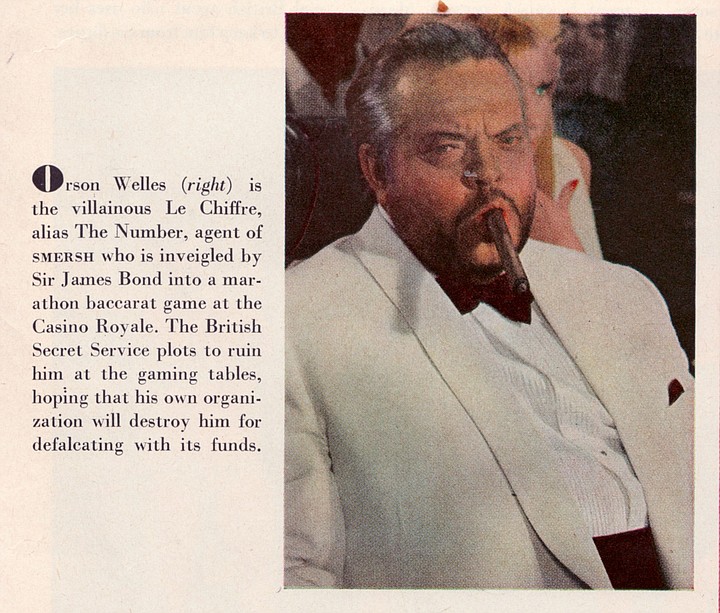
For years, I shrugged off the phrase “guilty pleasure.” Hot Rods to Hell and The Oscar have added more laughter to my life than most intentional comedies. Where’s the guilt? Certainly not at Casino Royale. And be sure to stick around for the closing credit theme — with lyrics. Move over Shirley Bassey and Tom Jones: Seven James Bonds at Casino Royale! They came to save the world and win a gal at Casino Royale. And before it's over, there's not one Bond left standing!


No, not that Casino Royale. The other, better one!
Casino Royale (1967)
We open with a postscript that can be found in the supplementary section of the DVD: it was Peter Sellers who suggested Orson Welles for the role of Le Chiffre in the 007 spy spoof Casino Royale, a move his ego later regretted. Sellers was so intimidated by Welles’ genius, he demanded the two not be filmed in the same shot. (Blows were exchanged when director Joe McGrath called him on it.) According to Sellers, who received an enormous salary plus a percentage of the gross, he walked off the set, never to return, because Welles and McGrath were ganging up on him. Months after monkey-wrenching the production, Sellers called director McGrath to arrange for a meeting over cocktails during which he apologized at length for his unprofessional behavior. McGrath recalls that in the middle of Sellers’ indefensible rant, one of Columbia Pictures’ head honchos walked over to the table to voice his own apologies to the director for everything that happened during the making of the film. He closed with, “And it was all that bastard Sellers’ fault.” According to McGrath, the executive then turned to Sellers and said, “We’re glad you’re here, Mr. Allen. It’s a pleasure to have you in our movie.” He walked away and Sellers said, “He thought I was Woody Allen. I’ve just had a check from him for a million dollars. And he signed it!”

By the time of its release in 1967, the term “James Bond spoof” had become oxymoronic. Forgive me, thou disciples of Bondage, but aside from Dr. No, From Russia With Love, and On Her Majesty’s Secret Service, everything that follows, in some shape or form, owes a debt to campy, gadgetry-enhanced buffoonery for the easily amused. Villains topped by razor-brimmed derbys or goliaths whose annual dental visits are paid to can-opener repairmen are the stuff comic books are made of. Want to see the greatest Bond film you have never heard of? Check out Pierce Brosnan in John Boorman’s The Tailor of Panama. Want to see the guiltiest of all Bond guilty pleasures? Welcome to Casino Royale.
It was the first 007 novel to be penned by Ian Fleming and the only one not owned by Cubby Broccoli and Harry Saltzman’s Eon Productions. Producer/Super Agent Charles K. Feldman acquired the rights from the wife of his late client, producer/actor Gregory Ratoff. All efforts to work with Eon and acquire the talent of Sean Connery failed. David Niven, Ian Fleming’s original choice to play Bond, was a bit befuddled by the choice of a Scotsman to play his undeniably British spy. Rather than go up against the franchise, Feldman pitched it as a comedy and Columbia bit. Niven’s Bond lives in an “Eden without an Eve” and contrary from popular belief, the greatest spy in history abstains from sex. He represents an era when spying was an alternative to war and a spy was a member of a “select and immaculate priesthood” devoted to their work and disinterested in the type of sexual acrobatics associated with the character.
At the time, anthology films — several directors assigned short segments of a thematically-linked whole — were almost as conspicuous as spy films. Feldman didn’t have much in the way of a sense of humor, as evidenced by his choice of directors: John Huston, Ken Hughes, Robert Parrish, stunt coordinator Richard Talmadge, Val Guest, and Joe McGrath. Of the six, only the latter two had any noticeable aptitude for comedy.

Who knows how much different the picture would have been had Sellers stuck it out? The smutty gag that opens the picture — Evelyn Tremble (Sellers) at an open-air Parisian urinal admiring Lieutenant Mathis’ (Duncan Macrae) “credentials” — was clearly intended to land much later in the film. As it is, it reflects a decision by committee, a harbinger of an oncoming spoof that only occasionally knows what it’s making fun of. After that, and for all too brief a moment, it appears as though Feldman looked to go head-to-head with the Eon series. Richard Williams’ animated opening credit sequence is right up there with the best of Maurice Binder. Check out the manner in which every actor’s credit foretells their character’s fate.
Huston’s decision to co-direct and act was made to the great delight of a bookie to whom he was in hock up to his orangutan-orange hairpiece. His segment opens the picture and if you can make it past the first 38 minutes, it’s relatively smooth, if narratively incoherent, sailing. According to Guest, Feldman instructed him to see how much footage they had of Sellers and if there was enough to continue on without him. When told yes, Feldman called Sellers in Spain and fired him. When Sellers leaves, the film careens away from comedy and in the direction of a psychedelic spoof. McGrath and Guest come off best, while Hughes and Parrish get lost trying to please the producer. (When asked if he’d like to be credited as “Segment Coordinator,” Guest called the film the least coordinated production he ever worked on.) Talmadge’s contribution oddly prefigures Blazing Saddles, what with its team of cowboys on horseback riding roughshod through the casino.

I was outraged the first time I saw this. It was nothing against Casino Royale, but rather, the sudden downpour halfway through the second feature, Jerry Lewis’ The Big Mouth, that necessitated an early exit from the drive-in. For years, I have championed it over Martin Campbell’s snoozefest royale. Seeing it again for the first time in over two decades, there are images that refuse to fade, most notably the slow-mo entrance of Sellers and Ursula Andress, underscored by Burt Bacharach’s “The Look of Love” and shot through an aquarium, bubbles gurgling like little diamonds that fill a quarter of the screen.
Jack Hildyard (Caesar and Cleopatra, The Bridge on the River Kwai, 55 Days at Peking) was a member of Britain’s old guard, a cinematographer who put time and care into crafting each shot. His insistence on using arc lights — they took 20 minutes to warm up — later caused McGrath to complain that they were lucky if they got a minute of film in the can each day. And a Bond film without Monte Norman’s iconic guitar theme might have felt more apparent had it not been for the score; Herb Alpert and the Tijuana Brass riding stereo herd on the title tune is as good a Bond theme as any out there. (This is the only 007 film to foster two hit songs.) Feldman knew as much about music as he did comedy. He called "The Look of Love" “artist shit,” and told Bacharach to remove it because it wasn’t funny. Thank God no one was listening.

For years, I shrugged off the phrase “guilty pleasure.” Hot Rods to Hell and The Oscar have added more laughter to my life than most intentional comedies. Where’s the guilt? Certainly not at Casino Royale. And be sure to stick around for the closing credit theme — with lyrics. Move over Shirley Bassey and Tom Jones: Seven James Bonds at Casino Royale! They came to save the world and win a gal at Casino Royale. And before it's over, there's not one Bond left standing!
Comments